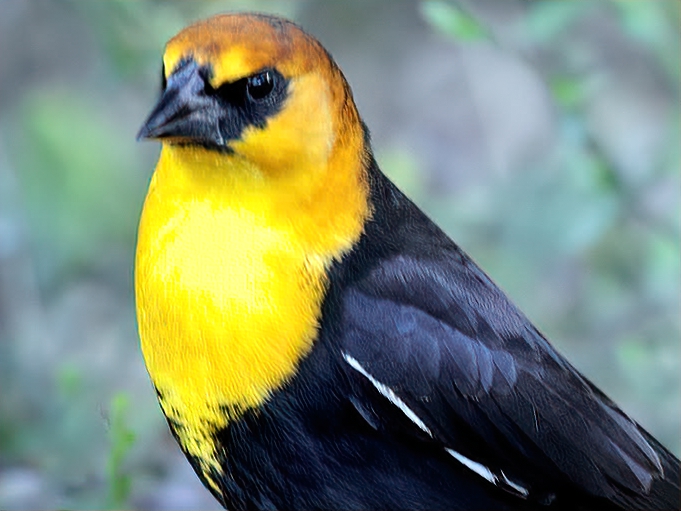by M. Kathy Raines
Throngs of noisy, migrating male yellow-headed blackbirds, heads and chests aglow in the setting sun, descended upon limbs and open swaths of lawn to forage for seeds and insects at South Padre Island Convention Center last April. I can hardly wait to see them again.

Our wondrous spring fall-out—during which fatigued and famished migrants stop to rest and refuel, will continue through May, with species following their varied timetables. Migrating diurnally in small, irregular flocks, yellow-headed blackbirds converge with red-winged blackbirds and others upon grassy lots, fields and pastures, usually in late April. Males leave southern wintering areas before females and juveniles.
The male’s brilliant yellow feathers contrast handsomely with his velvety black plumage, including an eye patch extending to a dark, sharp bill. He brandishes a white wing-patch in flight. The less conspicuous female has a whitish or yellowish throat, chin and cheeks, and a light yellow, streaked chest which brightens in wintertime. This stout blackbird (Xanthocephalus xanthocephalus), whose doubled scientific name is Greek for “yellow-headed”, is the species’ sole representative.
This blackbird breeds in freshwater marshes and reed-bordered lakes from Canadian grasslands down through much of the West and Midwest. It breeds as far south as the northern Texas Panhandle and winters in Mexico, Central America and parts of the Southwest.
Especially during wintertime, yellow-heads forage for seeds— about 2/3 of their diet—in marshes and grasslands. During breeding season, they, especially females, devour more insects—which they can catch in midair—snails, tadpoles and such. Like fellow blackbirds, they follow plows to snap up exposed worms and grubs.
Yellow-headed blackbirds breed colonially, with males arriving first to select breeding sites amidst reeds and cattails in two-to-four feet freshwater, a depth which provides some protection from predators. Fiercely defending their turf, they muscle out red-wing blackbirds—which nest above shallower water— and especially marsh hens, which puncture blackbird eggs. One male breeds with several females.
In the late 1980’s, biologists, pondering the function of the male’s stark colors, dyed the yellow parts of 12 male birds black, leaving 11 yellow-heads unaltered. The dyed males had no difficulty attracting mates and defending territories, and, curiously, 5 of them, unlike the untouched males, even regained superior sites. Perhaps, researchers posited, other birds recognized these blackened birds for their original adeptness in claiming turf.
A female builds an elaborate and sound nest—an open bowl attached to standing reeds overhanging the water—entwining the structures with leaves and rootlets. When it’s sufficiently thick, she drops material into the nest, stamping her feet audibly along bottoms and sides to pack the wet matter. When it’s dry, she lays about four eggs.
She feeds nestlings regurgitated invertebrates. Her mate, who supplies some food, provides defense. Also, should she sound an alarm, colony members flock to her aid. Chicks scramble through plants, hopping and even swimming a little. At three weeks, they fly a little.
Though intricate and varied, yellow-head vocalizations are anything but melodic, with even devotees likening them to rusty gates and saws. Especially during boundary disputes, a male, assuming a distinctive, asymmetrical posture, with toes gripping a wavery reed, emits a buzzing or growling song, with short, low descending notes, ending with an increasingly loud buzz. His accenting song, during which he spreads his wings, displaying his patch, consists of clear, separated notes, concluded at times with grackle-like sky-pointing. Other calls include the hawk alarm call, a harsh rattle begun by one male and repeated by others as they mob a raptor.

Like other blackbirds, yellow-heads may flock in murmuration, wherein thousands swoop and swirl together. Oddly, hundreds of them suddenly crashed to the ground one early February morning this year in Cuauhtémoc, Mexico. No one knows why, but some speculate that a raptor had descended upon the massive flock, creating confusion.
Yellow-headed blackbirds are faring well, but we must guard against habitat degradation, particularly the draining of wetlands. Unfortunately, since they eat crops, they are sometimes shot, poisoned, trapped or inadvertently killed by chemicals. Chiefly, we must avoid using poisons and sprays near breeding sites.

